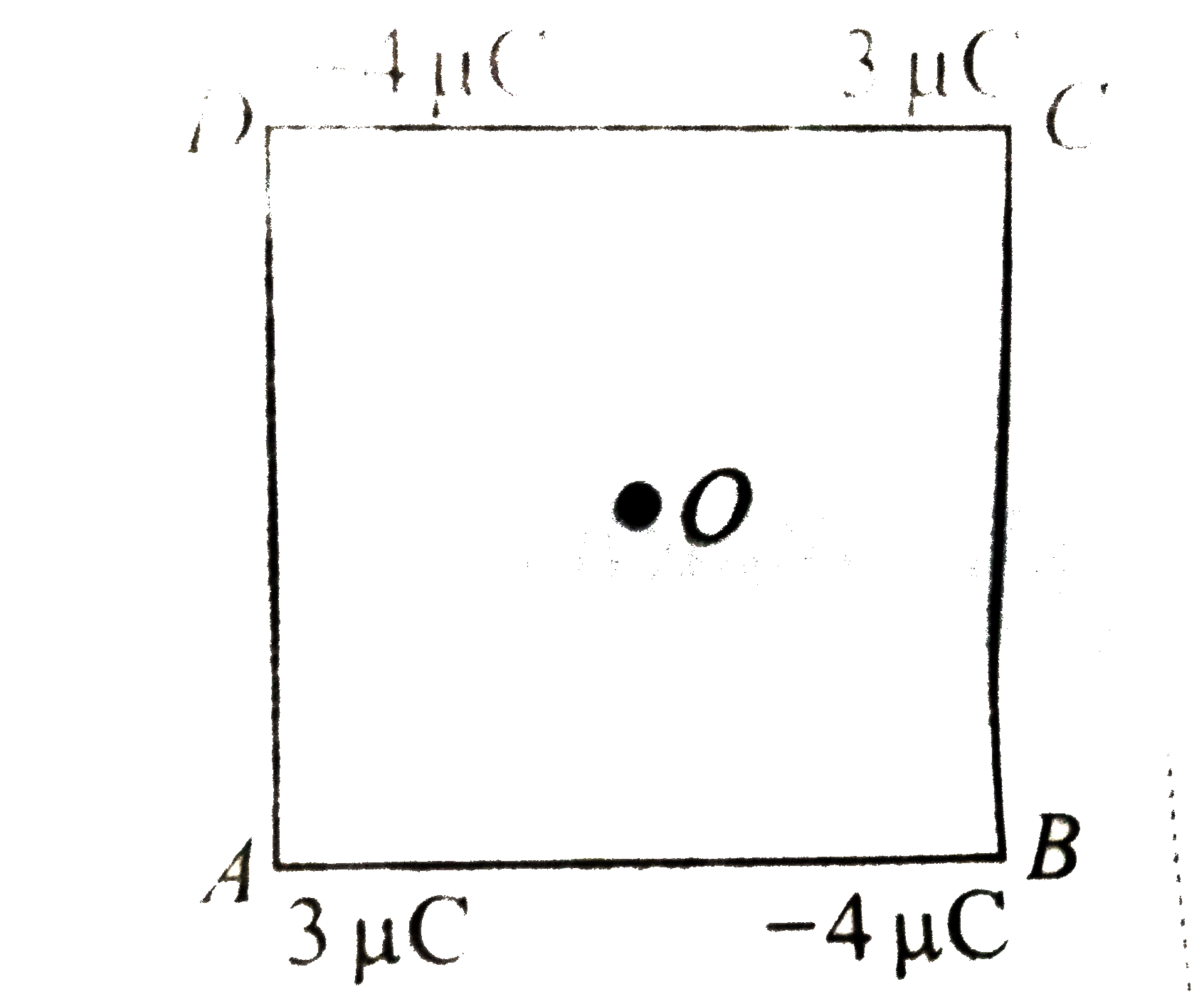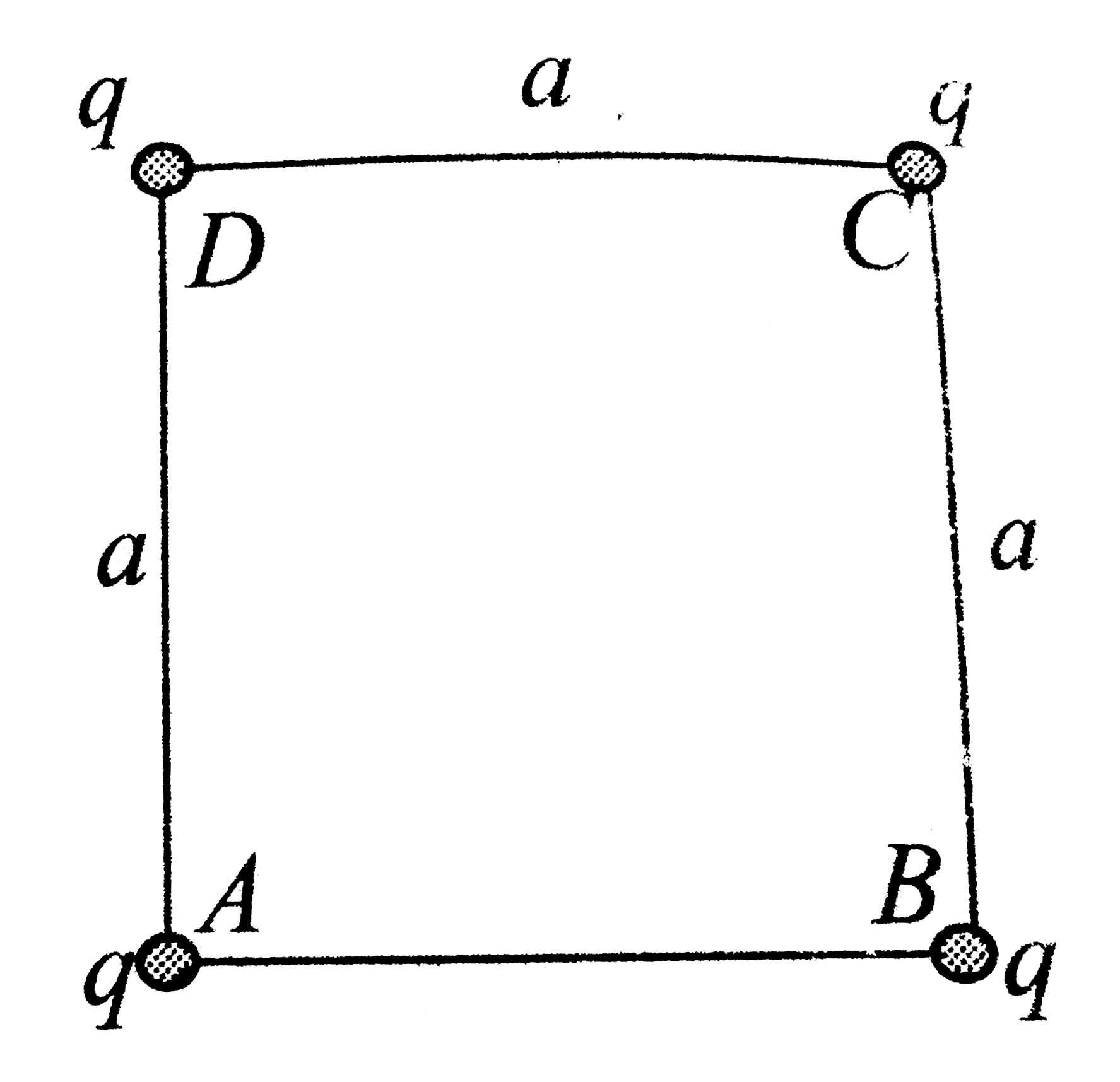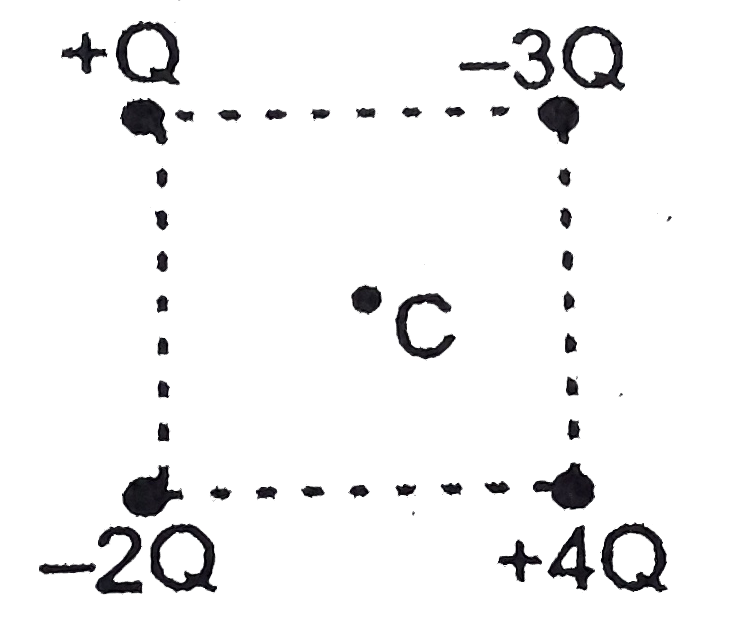Find the electric field and potential at the centre of a square of side d = 10 cm. Four identical charges of q=2μC each are kept at the four corners of a square.
To find the electric field and potential at the center of a square with side length d=10cm and four identical charges q=2μC located at the corners, we can follow these steps:
Step 1: Understand the Configuration
We have a square with four corners, each occupied by a charge of 2μC. The distance from the center of the square to each corner can be calculated using the Pythagorean theorem.
Step 2: Calculate the Distance from the Center to a Corner
The distance r from the center of the square to any corner can be calculated as follows:
r=d√2=10cm√2=10×10−2m√2=10−1√2m≈0.0707m
Step 3: Calculate the Electric Field Due to One Charge
The electric field E due to a point charge q at a distance r is given by:
E=k⋅qr2
where k=9×109N m2/C2.
Substituting the values:
E=9×109⋅2×10−6(0.0707)2
Calculating (0.0707)2:
(0.0707)2≈0.005
Thus,
E≈9×109⋅2×10−60.005=18×1030.005=3.6×106N/C
Step 4: Determine the Net Electric Field
Since the charges are identical and symmetrically placed, the electric fields due to opposite charges will cancel each other out. Therefore, the net electric field at the center of the square is:
Enet=0N/C
Step 5: Calculate the Electric Potential at the Center
The electric potential V at a point due to a point charge is given by:
V=k⋅qr
The total potential at the center due to all four charges is:
Vtotal=4⋅k⋅qr
Substituting the values:
Vtotal=4⋅9×109⋅2×10−60.0707
Calculating 2×10−60.0707:
2×10−60.0707≈2.83×10−5
Thus,
Vtotal=4⋅9×109⋅2.83×10−5≈1.02×106V
Final Results
- Electric Field at the Center: Enet=0N/C
- Electric Potential at the Center: Vtotal≈1.02×106V
We have a square with four corners, each occupied by a charge of 2μC. The distance from the center of the square to each corner can be calculated using the Pythagorean theorem.
The distance r from the center of the square to any corner can be calculated as follows:
r=d√2=10cm√2=10×10−2m√2=10−1√2m≈0.0707m
The electric field E due to a point charge q at a distance r is given by:
E=k⋅qr2
where k=9×109N m2/C2.
E=9×109⋅2×10−6(0.0707)2
Calculating (0.0707)2:
(0.0707)2≈0.005
Thus,
E≈9×109⋅2×10−60.005=18×1030.005=3.6×106N/C
Since the charges are identical and symmetrically placed, the electric fields due to opposite charges will cancel each other out. Therefore, the net electric field at the center of the square is:
Enet=0N/C
The electric potential V at a point due to a point charge is given by:
V=k⋅qr
The total potential at the center due to all four charges is:
Vtotal=4⋅k⋅qr
Substituting the values:
Vtotal=4⋅9×109⋅2×10−60.0707
Calculating 2×10−60.0707:
2×10−60.0707≈2.83×10−5
Thus,
Vtotal=4⋅9×109⋅2.83×10−5≈1.02×106V
- Electric Field at the Center: Enet=0N/C
- Electric Potential at the Center: Vtotal≈1.02×106V
Similar Questions
Calculate the electric potential at the center of a square of side √2m, having charges 100μc,−50μC,20μcand−60μC at the four corners of the square.
View SolutionThe gravitational potential at the centre of a square of side a when four point masses m each are kept at its vertices will be
View SolutionFour point charges qA=2μC,qB=−5μC,qC=2μCandqD=−5μC are located at the corners of a square ABCD of side 10 cm. What is the force on a charge of 1μC placed at the center of the square ?
View SolutionFour point charges are placed at the corners of a square ABCD of side 10 cm, as shown in figure. The force on a charge of 1μC placed at the centre of square is

View SolutionTwo positive charges of magnitude q are placed at the ends of a side ( side 1) of a square of side 2a . Two negative charges of the same magnitude are kept at the other corners . Staring from rest , a charge Q moves from the middle of side 1 to the centre of square , its kinetic energy at the centre of square is -.
View SolutionFour identical charges q are placed at the corners of a square of side a. Find the potential energy of one of the charges due to the remaining charges.
 .
.
View SolutionFour point charges are placed at the corners of a square of side l. Calculate potential at the centre of square.

View SolutionA point charge Q is placed at the corner of a square of side a. Find the flux through the square.
View SolutionThree charges, each equal to q, are placed at the three. corners of a square of side a . Find the electric field at. the fourth corner.
View SolutionThree charges, each equal to q, are placed at the three. corners of a square of side a . Find the electric field at. the fourth corner.
View Solution
